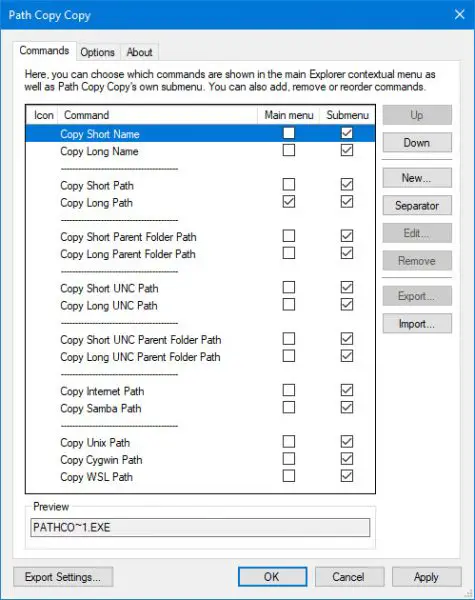
Show Path In Windows 10 Will Display
How to add to the PYTHONPATH in Windows, so it finds myHow can I add a python script to the windows. By default, Windows 10 will display the folder name alone in the title bar of File Explorer. Although we can show hidden files using the keyboard shortcut and GUI interface, however, if you are not a fan of Windows graphical file explorer and prefer to use a command line, then using that unhide files is possible as well.1 Install RSAT Feature on Demand on Windand Later1.1 RSAT on Windows 10 as Features on Demand (FoD)1.2 Install RSAT on Windows 10 with PowerShell1.3.
Show Path In How To Print The
To unhide files from some particular folder, the command will be Note: In the above command J: is the Drive letter and in that Drive, we want to unhide all files and folders. In case you want to remove hidden settings from all the system folders and files available inside a Drive, use attrib -H -S J:\*.* /S /D PATH is an environment variable that specifies a set of directories, separated with semicolons ( ), where executable programs are located.In this note i am showing how to print the contents of Windows PATH environment variable from the Windows command prompt.I am also showing how to add a directory to Windows PATH permanently or for the current session only.Cool Tip: List environment variables in Windows! Read More → Echo Windows PATH VariablePrint the contents of the Windows PATH variable from cmd: C:\> pathThe above commands return all directories in Windows PATH environment variable on a single line separated with semicolons ( ) that is not very readable.To print each entry of Windows PATH variable on a new line, execute: C:\> echo %PATH: =&echo.%Cool Tip: Set environment variables in Windows! Read More → Add To Windows PATHWarning! This solution may be destructive as Windows truncates PATH to 1024 characters. In the Task-Manager click More details and select the Tab Processes. Please use the keyboard-shortcut CTRL+ Shift + Esc to start the Windows 10 Task Manager. While programs running on Windows 10 or 11, it is easy to open the program path via Task Manager.

Show Path In Full List Of
If it’s still not working normally, try one of the other fixes below. Then right click on “Windows Explorer” and select “Restart”:There will be a brief flash while Windows restarts Windows Explorer/Finder, along with the taskbar and Start Menu.After that, try to open the Start Menu. But it also controls things like the Start Menu, the taskbar, and other applications.If you have an issue with the Start Menu, the first thing you can try to do is restart the “Windows Explorer” process in the Task Manager.To open the Task Manager, press Ctrl + Alt + Delete, then click the “Task Manager” button.Click “More details” to see a full list of open programs and background processes you’re running:Scroll through the list until you find the “Windows Explorer” process. How to restart Windows ExplorerWindows Explorer, which is now called File Explorer, is the application you use to browse your file system and open programs and files. And one of the more common bugs people running Windows 10 have faced is that the Start Menu suddenly stops working.Sometimes the open Start Menu freezes up and is unresponsive, and other times it won’t open at all when you click the Start Menu button.Whatever specific issue you’re having with the Windows 10 Start Menu, we’ll go over some quick and not so quick fixes in this article.
Don't worry about them – most are just warnings about why a program can't be reinstalled:When the Get-AppXPackage command is finished, restart your computer, log in, and try to open the Start Menu. You don't need to worry about the manifest files, though – it's just something Windows needs to run each program.Give it 5-10 minutes, and make sure you don't close the PowerShell window until it's finished.Note: You may see some scary looking errors pop up as the Get-AppXPackage command is running. How to reset the Start Menu with default Windows 10 appsThe next thing you can try is to reset the Start Menu entirely, along will all the Windows 10 apps that were preinstalled or installed from the Microsoft Store.To do this, you'll need to open PowerShell as an administrator – Command Prompt won't work for the command you'll run.There are many ways to open PowerShell, but one of the fastest ways is to use the Run program.Use the shortcut Windows Key + R to open the Run program, enter "powershell", then click the "OK" button:This should open up a PowerShell terminal with administrative privileges.In the PowerShell terminal, run the following command: Get-AppXPackage -AllUsers | Foreach The Get-AppXPackage command will attempt to reinstall all the default Windows apps, including the Start Menu and search bar.It will also register a manifest file for each program it reinstalls. Once you log back in, try to open the Start Menu to see if that fixed your issues.Note: You could also use Powershell to run the sfc /scannow command, but remember that you'll need to open an elevated Powershell terminal. Just be careful not to close the window while sfc is doing its thing.Once System File Checker is finished, you'll either see a report of all the files it replaced, or if everything was fine, you'll see a message like this:If System File Checker replaced any corrupt or missing system files, save all of your open work and restart your computer.

"Cortana, open the Start Menu"So those are all the ways to fix the Windows 10 Start Menu, listed from easiest to hardest.Did any of these methods work for you? Is there another way to open the Start Menu that I missed? Let me know about it on Twitter.


 0 kommentar(er)
0 kommentar(er)
